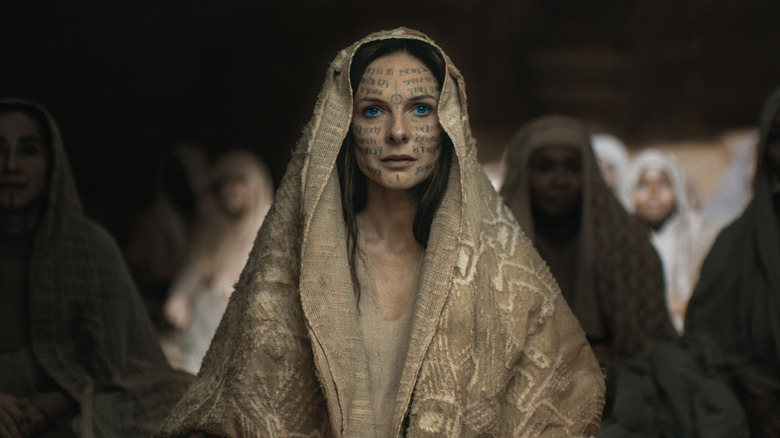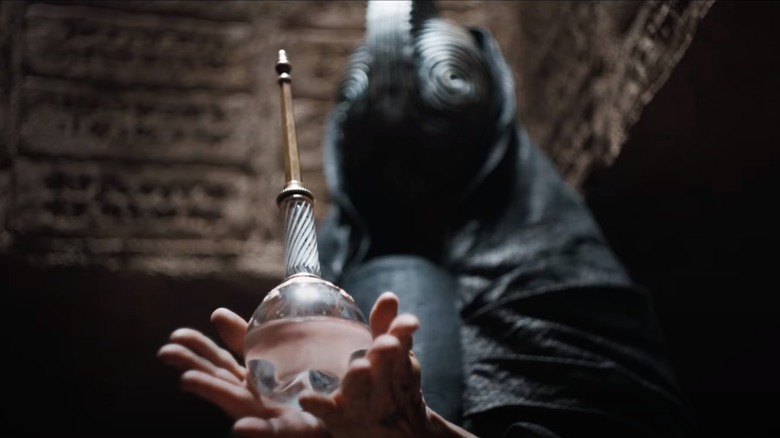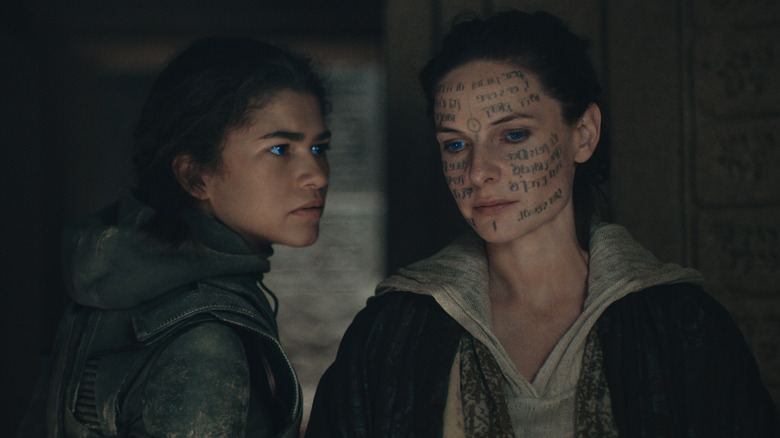Dune: Part Two's Water Of Life Explained, And What The Movie Doesn't Tell You
This article contains spoilers for "Dune: Part Two."
Just when you thought it was safe to go back in the water, director Denis Villeneuve's "Dune: Part Two" (check out our review here) decided to depict one of the strangest and most harrowing passages taken straight from the original book — one that introduces yet another way for the unwary to die on the desert world of Arrakis. The deceptively-named Water of Life sequence carries great import in both author Frank Herbert's story and the adaptation, forever altering the fates of both Lady Jessica (Rebecca Ferguson) and her son Paul Atreides (Timothée Chalamet) ... provided they survive their respective experiences with it, of course. In "Part Two," we watch this ritual performed two separate times for mother and son, both of which carry significant side-effects that ripple throughout the rest of their journey.
Although Villeneuve and co-writer Jon Spaihts' script remains incredibly faithful to the events laid down by Herbert, viewers might still come away from these scenes wondering exactly what's going on underneath the surface. Fortunately, the 1965 novel provides all the necessary context, background details, and foreboding omens for the future that any "Dune"-head could possibly need. The film provides just enough information to understand the basics of what's going on. Readers of the book(s), however, are aware that there's much more going on here than a mere rite of passage to be welcomed into the Fremen tribe or a final step for Paul to fully embrace his destiny. Here's everything you need to know (and a few things you probably don't) about the Water of Life in "Dune: Part Two."
The Water of Life explained
"Bless the Maker and his water" just took on a whole new meaning, didn't it? For the more religious members of the Fremen people, the massive sandworms that patrol the deepest reaches of the desert represent something far more than just the deadliest apex predators of the planet. Known as "Makers," they're considered to be physical embodiments of their god (also called Shai-Hulud) that rules over every facet of their desert-dwelling way of life. Ironically, however, sandworms have just one weakness: water, which is poisonous to them.
Taken together, this turn of phrase adds all sorts of layers to the Water of Life scenes depicted in "Dune: Part Two." Derived from the bile of an infant sandworm excreted at the moment of its drowning in water, the poisonous substance known as the Water of Life is used as a ritualistic practice to confirm the next matriarchal figure of the Fremen tribe (a title referred to as "Sayyadina" in the text). When Lady Jessica takes up the responsibility to cement her status within Stilgar's (Javier Bardem) sietch in the book, she does so without knowing just how much the Bene Gesserit influence has embedded itself in Fremen society. Their Water of Life test proves to be highly reminiscent of the Bene Gesserit process of inducting a Sister into a Reverend Mother — a terrible and incredibly dangerous ordeal that involves ingesting the fluid and falling into a fugue state, converting the toxins into a much more pliable substance, and thus awakening themselves to a level of prescience that only the Kwisatz Haderach himself could rival.
As a test used exclusively for women, however, no man has ever ingested the poison and lived to tell the tale ... until Paul Atreides, that is.
Paul's awakening
You know what they say about desperate times. With the Harkonnen grip on Arrakis threatening to reach a tipping point, the need to have a clear picture of the future — and all the threats it contains — convinces Paul to finally take the most drastic action of all. In the book, this decision is motivated chiefly by a brush with danger close to home. Gurney Halleck (Josh Brolin), under the misguided impression that the devious betrayer who helped the Harkonnens overthrow Duke Leto was Lady Jessica instead of Dr. Yueh (played by Chang Chen in the first "Dune"), nearly kills Jessica out of loyalty to the late Duke before Paul convinces him otherwise. Shaken by both the assassination attempt and the fact that his spice-enhanced foresight never once indicated that this might ever happen, Paul takes it upon himself to undergo the same Water of Life ceremony that his mother previously took and prove once and for all whether he is the legendary Kwisatz Haderach.
The rest of the sequence unfolds more or less as portrayed in the sequel. Upon taking the poison, Paul's vital signs drop to levels undetectable to anyone other than a Bene Gesserit. With his life on the line, Jessica summons her son's lover Chani (Zendaya) to do what she could not and help bring him back from the brink. But when this works and Paul awakens after weeks in a coma, he might as well be a completely different person from the one he was before. Now able to go where even the most powerful Bene Gesserit Reverend Mothers could not, Paul's supreme awareness of past and future confirms the truth: He is the Kwisatz Haderach. Yet that's only the beginning of the changes to come.
Unexpected consequences
Surviving the toughest of trials is one thing; walking away unscathed is another entirely.
If you thought drinking or smoking while pregnant was inadvisable, well, they haven't even invented a medical warning strong enough to go along with expectant mothers participating in the Water of Life ritual. In fairness to Jessica and as mentioned earlier, she never truly grasped that the Fremen custom involving the sandworm was so indebted to the Bene Gesserit method of installing a new Reverend Mother. By the time she (and the previous Fremen matriarch) realize that Jessica's pregnancy puts two lives at risk, it's far too late to stop. Instead, exposure to the poisonous substance turns the fetus into possibly one of the weirdest characters Frank Herbert ever created. We know from the briefest of flash-forwards that the infant will eventually grow up to be Paul's sister Alia (portrayed in a not-so-surprise cameo by Anya Taylor-Joy). But the aspect "Part Two" doesn't include is the fact that Alia matures unnaturally fast, developing a self-awareness far beyond her years that sets her on a troubling path.
Meanwhile, Paul's experience fully sets him on the course that eventually ends with him on the Emperor's throne. The ending of "Part Two" makes it abundantly clear that this the furthest thing from a triumphant hero's journey, but a direct refutation of such power fantasies — with untold ramifications to come. For Lady Jessica and Paul, the consequences of their respective encounters with the Water of Life become as clear and unavoidable as a Shakespearean tragedy. In one case, one life is irrevocably changed. In the other, millions upon millions of lives are set on another path entirely. Both come together to symbolize many of the tragic themes of "Dune."
"Dune: Part Two" is now playing in theaters.



